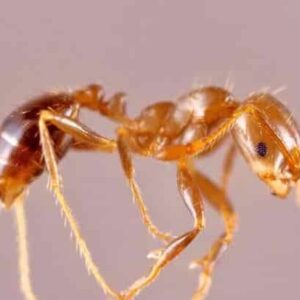
Fire Ant

Exploring the Fire Ant: Habits & Anatomy
Fire ants, notorious for their painful stings, are a common yet formidable presence in many landscapes. In this comprehensive insect library, we delve into the daily life of Fire ants, shedding light on their habits, anatomy, and the environmental impact they wield.
Fire ants, formally known as Solenopsis invicta, are versatile inhabitants, thriving in both urban and rural environments. These resilient insects build nests in soil mounds, often hidden in grassy areas, making them a potential threat in parks, yards, and agricultural landscapes.
Transitioning to their colonies, these critters showcase tenacious resilience. These industrious insects construct intricate nests, often reaching substantial sizes. Their adaptability allows them to thrive in diverse conditions, from moist soils to arid landscapes, ensuring their presence is felt far and wide.
Fire ants employ an efficient reproduction system that contributes to their rapid population growth. Queens lay eggs, and once hatched, the larvae develop into worker ants. This reproductive efficiency enables Fire ant colonies to expand swiftly, creating a formidable presence in their habitats.
As we explore their feeding habits, Fire ants reveal a voracious appetite for various foods. They are opportunistic scavengers, consuming dead insects, small invertebrates, and plant matter. Their foraging trails can lead them into homes, creating a nuisance for residents.
Environmental Impact and Life Cycle
The ecological impact of these insects extends beyond their painful stings. Their aggressive foraging behavior disrupts local ecosystems, affecting native insect populations and even small vertebrates. Understanding these consequences is pivotal for implementing effective pest control measures.
They are characterized by their small size, typically ranging from 1.6 to 5 millimeters. Their bodies are reddish-brown, with darker abdomens, and they possess a stinger at the rear. This diminutive yet formidable anatomy enables them to defend their colonies with painful stings.
The life cycle of Fire ants encompasses four stages: egg, larva, pupa, and adult. Queen ants lay eggs, and once hatched, the larvae undergo metamorphosis to become worker ants. Understanding this life cycle is crucial for developing targeted pest control strategies.
Professional Intervention: Calling Pest Busterzz for Fire Ant Challenges
Effectively managing Fire ant infestations requires a delicate balance between understanding their behavior and implementing preventive measures. Identifying and treating mounds, using baits strategically, and employing chemical treatments are practical strategies to curtail their invasive tendencies.
For persistent Fire ant problems, seeking professional help is a prudent choice. Pest control experts, armed with knowledge and proven interventions, can address infestations comprehensively. Passive voice is occasionally employed by pest control professionals when describing the process of tackling ant invasions.
Conclusion
In concluding this exploration of Fire ants, it is evident that these stinging invaders wield a substantial influence on both natural and human-made environments. By unraveling their habits, anatomy, and ecological consequences, homeowners and communities can make informed decisions to mitigate the challenges posed by Fire ant infestations. The key lies in coexistence strategies that balance effective pest control with an understanding of the role these formidable insects play in the intricate tapestry of our living spaces.

